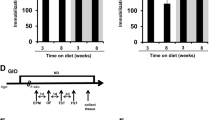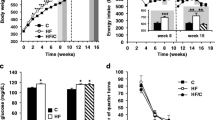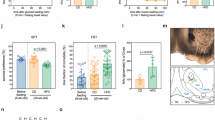Abstract
Epidemiological studies suggest a bidirectional association between depression and obesity; however, the biological mechanisms that link the development of depression to a metabolic disorder remain unclear. Even though nuclear receptor peroxisome proliferator-activated receptor γ (PPARγ) agonists show anti-depressive effect, and high-fat diet-(HFD)-induced PPARγ dysfunction is involved in the pathogenesis of metabolic disorders, the neuronal PPARγ has never been studied in HFD-induced depression. Thus, we aimed to investigate the effect of neuronal PPARγ on depressive-like behaviors in HFD-induced obese mice.
We fed male C57BL/6 J mice with HFD to generate obese mice and conducted a series of behavioral tests to assess the effects of HFD feeding on depression. We generated neuron-specific PPARγ knockout mice (NKO) to determine whether neuronal PPARγ deficiency was correlated with depressive-like behaviors. To further prove whether PPARγ in the medial prefrontal cortex (mPFC) neurons is involved in depressive-like behaviors, we applied AAV- CaMKIIα-Cre approach to specifically knockout PPARγ in the mPFC neurons of LoxP mice and used AAV-syn-PPARγ vectors to overexpress PPARγ in the mPFC neurons of NKO mice.
We observed a low mPFC PPARγ level and an increase in depressive-like behaviors in the HFD-fed mice. Moreover, neuronal-specific PPARγ deficiency in mice induced depressive-like behaviors, which could be abolished by imipramine. Furthermore, overexpressing PPARγ in the mPFC reversed the depressive-like behaviors in HFD-fed mice as well as in neuronal-specific PPARγ knockout mice.
These results implicate that dysregulation of neuronal PPARγ in the mPFC may contribute to an increased risk for depression in obese populations.




Similar content being viewed by others
Data Availability
All datasets generated and analyzed during this study are included in this published article and its supplementary information files. Materials are available upon request.
Abbreviations
- PPARγ:
-
Peroxisome proliferator-activated receptor gamma
- CNS:
-
Central nervous system
- FST:
-
Forced swim test
- TST:
-
Tail suspension test
- HFD:
-
High-fat diet
- mPFC:
-
Medial prefrontal cortex
- CaMKIIα:
-
Calcium/calmodulin-dependent protein kinase II alpha
- GTT:
-
Glucose tolerance test
- CSDS:
-
Chronic social defeat stress
- SPT:
-
Sucrose preference test
- CDK5:
-
Cyclin-dependent kinase 5
- FGF2:
-
Fibroblast growth factor 2
- VAMP2:
-
Vesicle-associated membrane protein 2
- STXBP5:
-
Syntaxin-binding protein 5
- POMC:
-
Proopiomelanocortin
- ATCH:
-
Adrenocorticotrophic hormone
- GR:
-
Glucocorticoid receptor
- HPA:
-
Hypothalamus–pituitary–adrenal
- BDNF:
-
Brain-derived neurotrophic factor
References
Krishnan V, Nestler EJ (2008) The molecular neurobiology of depression. Nature 455(7215):894–902. https://doi.org/10.1038/nature07455
Berton O, Nestler EJ (2006) New approaches to antidepressant drug discovery: beyond monoamines. Nat Rev Neurosci 7(2):137–151. https://doi.org/10.1038/nrn1846
Castren E (2013) Neuronal network plasticity and recovery from depression. JAMA Psychiat 70(9):983–989. https://doi.org/10.1001/jamapsychiatry.2013.1
Pan A, Sun Q, Czernichow S, Kivimaki M, Okereke OI, Lucas M, Manson JE, Ascherio A, Hu FB (2012) Bidirectional association between depression and obesity in middle-aged and older women. Int J Obes 36(4):595–602. https://doi.org/10.1038/ijo.2011.111
Anderson RJ, Freedland KE, Clouse RE, Lustman PJ (2001) The prevalence of comorbid depression in adults with diabetes: a meta-analysis. Diabetes Care 24(6):1069–1078
Luppino FS, de Wit LM, Bouvy PF, Stijnen T, Cuijpers P, Penninx BW, Zitman FG (2010) Overweight, obesity, and depression: a systematic review and meta-analysis of longitudinal studies. Arch Gen Psychiatry 67(3):220–229. https://doi.org/10.1001/archgenpsychiatry.2010.2
Hryhorczuk C, Sharma S, Fulton SE (2013) Metabolic disturbances connecting obesity and depression. Front Neurosci 7:177. https://doi.org/10.3389/fnins.2013.00177
Capuron L, Su S, Miller AH, Bremner JD, Goldberg J, Vogt GJ, Maisano C, Jones L, Murrah NV, Vaccarino V (2008) Depressive symptoms and metabolic syndrome: is inflammation the underlying link? Biol Psychiat 64(10):896–900. https://doi.org/10.1016/j.biopsych.2008.05.019
Willson TM, Lambert MH, Kliewer SA (2001) Peroxisome proliferator-activated receptor gamma and metabolic disease. Annu Rev Biochem 70:341–367. https://doi.org/10.1146/annurev.biochem.70.1.341
Choi JH, Banks AS, Estall JL, Kajimura S, Bostrom P, Laznik D, Ruas JL, Chalmers MJ, Kamenecka TM, Bluher M, Griffin PR, Spiegelman BM (2010) Anti-diabetic drugs inhibit obesity-linked phosphorylation of PPARgamma by Cdk5. Nature 466(7305):451–456. https://doi.org/10.1038/nature09291
Ji-Rong Y, Bi-Rong D, Chang-Quan H, Zhen-Chan L, Hong-Mei W, Yan-Ling Z, Mattis TA (2009) Pro12Ala polymorphism in PPARgamma2 associated with depression in Chinese nonagenarians/centenarians. Arch Med Res 40(5):411–415. https://doi.org/10.1016/j.arcmed.2009.05.005
Eissa Ahmed AA, Al-Rasheed NM, Al-Rasheed NM (2009) Antidepressant-like effects of rosiglitazone, a PPARgamma agonist, in the rat forced swim and mouse tail suspension tests. Behav Pharmacol 20(7):635–642. https://doi.org/10.1097/FBP.0b013e328331b9bf
Guo M, Li C, Lei Y, Xu S, Zhao D, Lu XY (2017) Role of the adipose PPARgamma-adiponectin axis in susceptibility to stress and depression/anxiety-related behaviors. Mol Psychiatry 22(7):1056–1068. https://doi.org/10.1038/mp.2016.225
Zhou L, Yin J, Wang C, Liao J, Liu G, Chen L (2014) Lack of seipin in neurons results in anxiety- and depression-like behaviors via down regulation of PPARgamma. Hum Mol Genet 23(15):4094–4102. https://doi.org/10.1093/hmg/ddu126
Casanova E, Fehsenfeld S, Mantamadiotis T, Lemberger T, Greiner E, Stewart AF, Schutz G (2001) A CamKIIalpha iCre BAC allows brain-specific gene inactivation. Genesis 31(1):37–42. https://doi.org/10.1002/gene.1078
Zhao X, Strong R, Zhang J, Sun G, Tsien JZ, Cui Z, Grotta JC, Aronowski J (2009) Neuronal PPARgamma deficiency increases susceptibility to brain damage after cerebral ischemia. The Journal of neuroscience : the official journal of the Society for Neuroscience 29(19):6186–6195. https://doi.org/10.1523/JNEUROSCI.5857-08.2009
Yang Y, Qin X, Liu S, Li J, Zhu X, Gao T, Wang X (2011) Peroxisome proliferator-activated receptor gamma is inhibited by histone deacetylase 4 in cortical neurons under oxidative stress. J Neurochem 118(3):429–439. https://doi.org/10.1111/j.1471-4159.2011.07316.x
Cao X, Li LP, Wang Q, Wu Q, Hu HH, Zhang M, Fang YY, Zhang J, Li SJ, Xiong WC, Yan HC, Gao YB, Liu JH, Li XW, Sun LR, Zeng YN, Zhu XH, Gao TM (2013) Astrocyte-derived ATP modulates depressive-like behaviors. Nat Med 19(6):773–777. https://doi.org/10.1038/nm.3162
Qin XH, Wu Z, Dong JH, Zeng YN, Xiong WC, Liu C, Wang MY, Zhu MZ, Chen WJ, Zhang Y, Huang QY, Zhu XH (2019) Liver soluble epoxide hydrolase regulates behavioral and cellular effects of chronic stress. Cell reports 29 (10):3223–3234 e3226. https://doi.org/10.1016/j.celrep.2019.11.006
Lam YY, Tsai SF, Chen PC, Kuo YM, Chen YW (2021) Pioglitazone rescues high-fat diet-induced depression-like phenotypes and hippocampal astrocytic deficits in mice. Biomedicine & pharmacotherapy = Biomedecine & pharmacotherapie 140:111734. https://doi.org/10.1016/j.biopha.2021.111734
Cheng Y, Rodriguiz RM, Murthy SR, Senatorov V, Thouennon E, Cawley NX, Aryal DK, Ahn S, Lecka-Czernik B, Wetsel WC, Loh YP (2015) Neurotrophic factor-alpha1 prevents stress-induced depression through enhancement of neurogenesis and is activated by rosiglitazone. Mol Psychiatry 20(6):744–754. https://doi.org/10.1038/mp.2014.136
Can A, Dao DT, Arad M, Terrillion CE, Piantadosi SC, Gould TD (2012) The mouse forced swim test. Journal of visualized experiments : JoVE 59:e3638. https://doi.org/10.3791/3638
Steru L, Chermat R, Thierry B, Simon P (1985) The tail suspension test: a new method for screening antidepressants in mice. Psychopharmacology 85(3):367–370
Ribeiro MA, Aguiar RP, Scarante FF, Fusse EJ, de Oliveira RMW, Guimaraes FS, Campos AC (2021) Spontaneous activity of CB2 receptors attenuates stress-induced behavioral and neuroplastic deficits in male mice. Front Pharmacol 12:805758. https://doi.org/10.3389/fphar.2021.805758
Golden SA, Covington HE 3rd, Berton O, Russo SJ (2011) A standardized protocol for repeated social defeat stress in mice. Nat Protoc 6(8):1183–1191. https://doi.org/10.1038/nprot.2011.361
Kirshenbaum GS, Saltzman K, Rose B, Petersen J, Vilsen B, Roder JC (2011) Decreased neuronal Na+, K+ -ATPase activity in Atp1a3 heterozygous mice increases susceptibility to depression-like endophenotypes by chronic variable stress. Genes Brain Behav 10(5):542–550. https://doi.org/10.1111/j.1601-183X.2011.00691.x
Zhao Q, Wu X, Yan S, Xie X, Fan Y, Zhang J, Peng C, You Z (2016) The antidepressant-like effects of pioglitazone in a chronic mild stress mouse model are associated with PPARgamma-mediated alteration of microglial activation phenotypes. J Neuroinflammation 13(1):259. https://doi.org/10.1186/s12974-016-0728-y
Zhang M, Radford KD, Driscoll M, Purnomo S, Kim J, Choi KH (2019) Effects of subanesthetic intravenous ketamine infusion on neuroplasticity-related proteins in the prefrontal cortex, amygdala, and hippocampus of Sprague-Dawley rats. IBRO reports 6:87–94. https://doi.org/10.1016/j.ibror.2019.01.006
Liu J, Guo M, Zhang D, Cheng SY, Liu M, Ding J, Scherer PE, Liu F, Lu XY (2012) Adiponectin is critical in determining susceptibility to depressive behaviors and has antidepressant-like activity. Proc Natl Acad Sci USA 109(30):12248–12253. https://doi.org/10.1073/pnas.1202835109
Moreno S, Farioli-Vecchioli S, Ceru MP (2004) Immunolocalization of peroxisome proliferator-activated receptors and retinoid X receptors in the adult rat CNS. Neuroscience 123(1):131–145. https://doi.org/10.1016/j.neuroscience.2003.08.064
Krishnan V, Han MH, Graham DL, Berton O, Renthal W, Russo SJ, Laplant Q, Graham A, Lutter M, Lagace DC, Ghose S, Reister R, Tannous P, Green TA, Neve RL, Chakravarty S, Kumar A, Eisch AJ, Self DW, Lee FS, Tamminga CA, Cooper DC, Gershenfeld HK, Nestler EJ (2007) Molecular adaptations underlying susceptibility and resistance to social defeat in brain reward regions. Cell 131(2):391–404. https://doi.org/10.1016/j.cell.2007.09.018
Xu P, Chen A, Li Y, Xing X, Lu H (2019) Medial prefrontal cortex in neurological diseases. Physiol Genomics 51(9):432–442. https://doi.org/10.1152/physiolgenomics.00006.2019
Eckel-Mahan KL, Patel VR, de Mateo S, Orozco-Solis R, Ceglia NJ, Sahar S, Dilag-Penilla SA, Dyar KA, Baldi P, Sassone-Corsi P (2013) Reprogramming of the circadian clock by nutritional challenge. Cell 155(7):1464–1478. https://doi.org/10.1016/j.cell.2013.11.034
Kemp DE, Ismail-Beigi F, Calabrese JR (2009) Antidepressant response associated with pioglitazone: support for an overlapping pathophysiology between major depression and metabolic syndrome. Am J Psychiatry 166(5):619. https://doi.org/10.1176/appi.ajp.2008.08081195
Kemp DE, Ismail-Beigi F, Ganocy SJ, Conroy C, Gao K, Obral S, Fein E, Findling RL, Calabrese JR (2012) Use of insulin sensitizers for the treatment of major depressive disorder: a pilot study of pioglitazone for major depression accompanied by abdominal obesity. J Affect Disord 136(3):1164–1173. https://doi.org/10.1016/j.jad.2011.06.033
Kariharan T, Nanayakkara G, Parameshwaran K, Bagasrawala I, Ahuja M, Abdel-Rahman E, Amin AT, Dhanasekaran M, Suppiramaniam V, Amin RH (2015) Central activation of PPAR-gamma ameliorates diabetes induced cognitive dysfunction and improves BDNF expression. Neurobiol Aging 36(3):1451–1461. https://doi.org/10.1016/j.neurobiolaging.2014.09.028
Thouennon E, Cheng Y, Falahatian V, Cawley NX, Loh YP (2015) Rosiglitazone-activated PPARgamma induces neurotrophic factor-alpha1 transcription contributing to neuroprotection. J Neurochem 134(3):463–470. https://doi.org/10.1111/jnc.13152
Nenov MN, Laezza F, Haidacher SJ, Zhao Y, Sadygov RG, Starkey JM, Spratt H, Luxon BA, Dineley KT, Denner L (2014) Cognitive enhancing treatment with a PPARgamma agonist normalizes dentate granule cell presynaptic function in Tg2576 APP mice. The Journal of neuroscience : the official journal of the Society for Neuroscience 34(3):1028–1036. https://doi.org/10.1523/JNEUROSCI.3413-13.2014
Torres RC, Magalhaes NS, PM ES, Martins MA, Carvalho VF, (2016) Activation of PPAR-gamma reduces HPA axis activity in diabetic rats by up-regulating PI3K expression. Exp Mol Pathol 101(2):290–301. https://doi.org/10.1016/j.yexmp.2016.10.002
Villapol S (2018) Roles of peroxisome proliferator-activated receptor gamma on brain and peripheral inflammation. Cell Mol Neurobiol 38(1):121–132. https://doi.org/10.1007/s10571-017-0554-5
Beurel E, Toups M, Nemeroff CB (2020) The bidirectional relationship of depression and inflammation: double trouble. Neuron 107(2):234–256. https://doi.org/10.1016/j.neuron.2020.06.002
Funding
This work was supported by the National Natural Science Foundation of China (81971234), the Program for Changjiang Scholars and Innovative Research Team in University (IRT_16R37), the Key Area Research and Development Program of Guangdong Province (2018B030334001 and 2018B030340001), and the Science and Technology Program of Guangzhou (202007030013).
Author information
Authors and Affiliations
Contributions
C.C. Fu: contributed to the conception of the study, performed the experiment, collected the data, and wrote the manuscript; X.Y. Zhang: performed the data analyses;
L. Xu and S. Xu helped to produce the HFD-induced obese mice and conducted the behaviors test; Q.Q. Wu, Z. Wang, L.F. Lin, and H.X. Huang contributed to produce and validate the PPARγfl/fl mice and neuronal-specific PPARγ knockout mice; X. Gu, S. Lin, and Y.Y. Fang helped with the data collection and experiments preparation; X. Cao helped designed the study; X.M. Wang designed the study, revised the manuscript, and oversaw the entire project.
Corresponding author
Ethics declarations
Ethics Approval
All experiments animals were performed with the approval of the Southern Medical University Animal Ethics Committee.
Consent to Participate
Not applicable.
Consent for Publication
All authors have given consent for publication.
Competing Interests
The authors declare no competing interests.
Additional information
Publisher's Note
Springer Nature remains neutral with regard to jurisdictional claims in published maps and institutional affiliations.
Supplementary Information
Below is the link to the electronic supplementary material.
Rights and permissions
About this article
Cite this article
Fu, CC., Zhang, XY., Xu, L. et al. PPARγ Dysfunction in the Medial Prefrontal Cortex Mediates High-Fat Diet-Induced Depression. Mol Neurobiol 59, 4030–4043 (2022). https://doi.org/10.1007/s12035-022-02806-6
Received:
Accepted:
Published:
Issue Date:
DOI: https://doi.org/10.1007/s12035-022-02806-6




